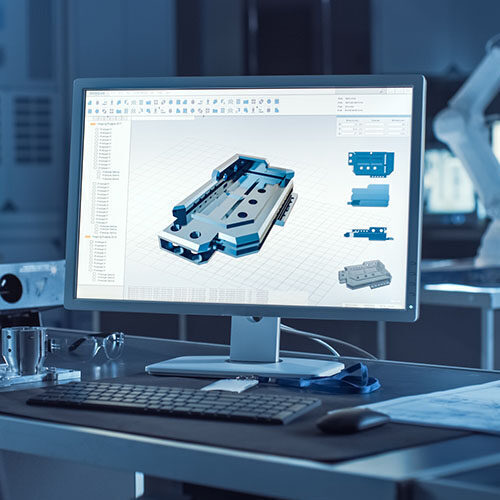
Manufacturers need to keep an eye on their bottom line now more than ever. Improving inventory management practices is one of the biggest areas where manufacturers can make changes and save thousands — even hundreds of thousands of dollars. Read on to learn 5 ways ERP software can help you get better control over your inventory.
ERP Inventory Management
Inventory management involves overseeing all of your inventory and stock.
Inventory management requires keeping an eye on the ordering, storage, and allocation of inventory to ensure you always have the right amount of inventory on hand. Effective inventory management practices reduce waste, save time, and lower costs. With good habits and systems in place, you will avoid dreaded stock emergencies and improve your shop’s efficiency and performance.
One of the best decisions you can make as a custom manufacturer is to use an ERP system for managing inventory. Fully integrated inventory management systems, like those found within a manufacturing-specific ERP, will provide you with an accurate inventory count in real time. With one simplified and completely integrated system, you can monitor your inventory needs, manage costs, and replenish stock based on actual on-the-job demand.
ERP inventory management software lets you keep tabs on your inventory down to the serial number, preventing production interruptions by eliminating unexpected material shortages. Additionally, everyone in your shop will always know what’s in stock and where to find it, saving time and improving shop floor efficiency.
5 Ways an ERP Will Improve Inventory Management
1.Automation
The biggest mistake to avoid with inventory management is thinking you can do it yourself using spreadsheets and manual counts.
Using an ERP system to handle inventory management will save you time, money, and lots of hassles and headaches. Instead of spreadsheets that need to be kept up-to-date manually you will have an automated dashboard with your real-time inventory counts. Not only will your counts be more more accurate, you will save all that time (and money) it takes to do inventory by hand.
RELATED ARTICLE: Motrec International saved $400,000 after using Genius ERP’s inventory management features
Almost everything related to inventory management is automated within an ERP system, giving you the confidence and time to get the job done right. ERP software allows you to automate purchase orders for both your suppliers or customers, as well as includes automated inventory re-stocking features that will inform you when stock levels are running low. Some ERPs will even take it a step further and automatically place an order when stock levels reach a certain level, giving you complete peace of mind that you will always have the raw materials and parts you need on hand.
2.Real-time Inventory Tracking
Real-time tracking of inventory — down to the second and serial number — keeps you organized and on top of your operations.
Real-time inventory tracking automatically updates your inventory data to match your actual inventory. Without real-time tracking your shop will be out of sync, and you won’t be sure if you actually have stock on hand. Nothing is worse than thinking you have raw materials sitting on the shelf ready for a job, and then finding out your inventory data hasn’t been properly updated. If you have multiple locations, these problems only increase.
With an ERP, your staff has immediate access to a central inventory database that is updated in real-time. This increases production efficiency — and even makes reporting simpler — by letting you know exactly what you can or cannot fulfill at any given moment, what raw materials you have on hand, and ensures your data corresponds to what is on your shelf. Bar code scanning and other built in features and tools make it easy to track inventory with little effort, to ensure your inventory counts are always accurate.
3.Full Integration
Inventory management systems are great, but integrated inventory management systems are better.
When your inventory management system is fully integrated with the rest of your operations, it makes not only improves your inventory management, but it makes, accounting, production planning, procurement, and reporting easier. Your manufacturing business will become more organized, streamlined, and effective as a result of being able to handle all aspect of operations through a single system.
Everyone across your organization will have acces to accurate and updated inventory data, saving them time, giving them accurate figures, and making their jobs easier.
4.Inventory KPIs
It’s almost impossible to make improvements if you can’t track what is going on in your organization.
An ERP supplies you with lots of data about your inventory, so you can track what is going well and where you need improvement in terms of your inventory management practices.
Inventory key performance indicators (KPIs) monitor the performance of your inventory over a specified period and provide you with precise measures for each week, month, quarter, or year. Monitoring KPIs, such as order status and tracking, carrying costs, inventory write-off rates, and inventory turnover, will let you know where problems exist and if you are improving over time in key areas.
5.Forecasting and Managing Excess Inventory
Forecasting inventory levels is more important now than it ever has been.
In the past, most manufacturers didn’t have to worry about material shortages, but now supply chain issues and material shortages are one of the biggest challenges affecting the industry. Accurate forecasting can help you to know what you need, giving you more time to procure items and keep your shop running efficiently. An ERP system tracks your sales, purchases, and logistics so you can maintain the proper stock levels to meet your company’s needs. More accurate data means you can make better more informed decisions about your business, to keep your shop profitable.
Excess inventory can eat into your profits without you even noticing. Maybe you purchased more than you needed, because you got it at a good price, but have since realized that the carrying costs are too high, or maybe there is a dip in customer demand for one of your products. Real-time insights into surplus inventory on your shelves gives you the chance to return unused materials before deadlines pass, reducing costs.
The Bottom Line
Every business owner knows that efficiency equals cost savings. Using an ERP for inventory management makes you more organized, saves time and energy, and lowers your costs. Accurate real-time inventory counts ensure you always have parts ready for a job, avoiding shutdowns and improving efficiency.
By automating and streamlining operations, ERP inventory management systems cut down time spent taking inventory, ultimately resulting in cost savings. Optimizing stock levels and improving inventory management practices equals more jobs out the door on time and on budget — improving your bottom line.
Get your eBook Scared to implement a new ERP?
"*" indicates required fields



